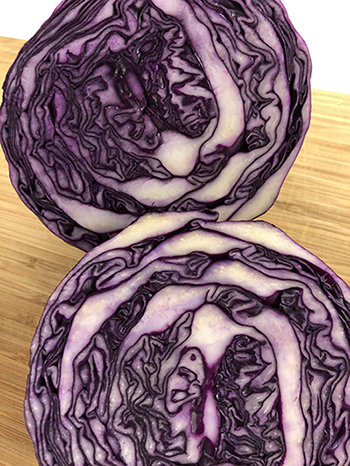by Kristen Smeal, Master Gardener
Brightly colored fruits and vegetables not only add a pop of color to the table, they also add an abundance of nutrients and fun. Summertime yields a colorful palate of vegetables and fruits: red, yellow and purple tomatoes; green and yellow cucumbers; navy blueberries and purple eggplants. But why should summer fruits and vegetables get to have all the fun? Here are some fall and winter fruits and vegetables that can put a rainbow of taste, nutrients, and art projects on the table.
Beets
Interplanting with red and golden varieties will delight the eyes and help children get nutrients such as fiber, folate, potassium, iron, and vitamin C. The flavor, while sweet, can be earthy and unappealing to children, but the color is intriguing. Try adding beets to plain whole wheat pasta for a pop of pink color or add boiled beets to a fruit smoothie for a vitamin burst. Beets can also be used as a natural dye for cloth. Place whole beets (greens removed) in a pot of water an inch above the tops. Cover and simmer on low heat for about an hour. Remove the beets with a slotted spoon and repurpose them in a recipe. Once the dye cools, it’s ready to use. Soak the cloth in the dye until desired color is achieved. Be careful not to get the dye anywhere you don’t want it to be, it will not come out. Squeeze and rinse the cloth with cold water and hang dry to set. Be careful to only wash it in cold water and not with light colored garments, as the fabric does have a tendency to bleed. The remaining dye can be saved in the refrigerator for subsequent dyeing projects!
Swiss Chard
This native Mediterranean vegetable grows well in low-water and poor soil areas. It can also be grown in a container on a balcony or porch and in a low-light area. Chard has been called a “powerhouse” of nutrients for a good reason. As a member of the dark, leafy green vegetable family, chard is full of vitamins and minerals, including Vitamin A, D, E, K, and Calcium. The fiber rich stalks can be a bit bitter so, if they are sauteed, it’s best to counteract this with garlic and onions. Chard leaves and stems can be easily added to soups and stews. For children who aren’t a fan of greens, the leaves can be chopped finely into ribbons and “hidden” in red pasta sauce. Here’s another fun recipe using chard: Eggs in a Nest.
Pumpkins
As mentioned in Five Best Vegetables to Grow with Children, children love watching pumpkins grow. From the flowers, these winter squash round into magical orange fruits seemingly overnight. Aside from the fun of growing the carving varieties, the edible variety like Sugar Pie Pumpkins are quite delicious and nutritious. High in beta-carotene, this low calorie squash can be used as a base for soup or curry, or for baking muffins or pie. As a real bonus, the seeds, when roasted, are an edible fiber-rich treat. Separate the seeds from the pulp and let them dry for 24 hours in a single layer on a paper towel lined baking tray. Try tossing them in melted coconut oil (3TBS), then in a mixture of cinnamon (1tsp.) and sugar (4TBS). Bake at 325 for 25-35 minutes, stirring every 10 minutes. Note: pumpkins will need to be planted now in order to set fruit this Fall.
Red Cabbage
Red cabbage can take a lot of space in the garden, but because it can grow in cooler temperatures and in partial shade, it’s easy to wiggle in around the edges. If growing red cabbage in pots, make sure the soil is well-draining and not in full sun. Red cabbage is not only beautiful, it has ten times the Vitamin A and two times the amount of iron than green cabbage. Try using finely chopped red cabbage to give tacos or sandwiches an extra crunch or adding it to lentil soup. For a fun art project, halve or quarter a head of cabbage, paint it with some washable paints and use it as a stamp on plain paper. The designs are amazing! When cooked in a pot of water, red cabbage produces a blueish-purple dye that can be used the same way beet dye is used above.
Lemons
Lemons can be grown in the ground, in a container, or as a houseplant (with the right variety). The juice can be used in many different cooking and baking dishes. The sour flavor of lemons is due to citric acid content and can be used to teach children about taste buds. The tip of the tongue senses sweet and salty, while the sides and back sense sour and bitter. Try holding a lemon wedge to the different areas of the tongue to see if the taste seems different. For another fun experiment, have children taste fruit from different parts of the tree. The fruits on the top, outside, and South facing side will tend to be sweeter because of more exposure to the sun. Keep in mind when picking out a tree, standard sized lemon trees can grow up to 22 feet tall, while the more manageable dwarf varieties will stay between 8-12 feet. For growing tips and help choosing a variety or planting site, see Four Winds Growers website. When the tree proves prolific and everyone has grown tired of over-sweetened (or not) lemonade, contact ABG’s Project Pick.
Enjoy the Rainbow!


